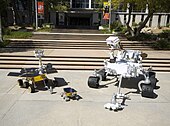The Jet Propulsion Laboratory (JPL) is a federally funded research and development center and NASA field center in La Cañada Flintridge, California and Pasadena, California, United States.
The JPL is owned by NASA and managed by the nearby California Institute of Technology (Caltech) for NASA. The laboratory's primary function is the construction and operation of planetary robotic spacecraft, though it also conducts Earth-orbit and astronomy missions. It is also responsible for operating NASA's Deep Space Network.
Among the laboratory's major active projects are the Mars Science Laboratory mission (which includes the Curiosity rover), the Mars Exploration Rover Opportunity, the Mars Reconnaissance Orbiter, the Dawn mission to the dwarf planet Ceres and asteroid Vesta, the Juno spacecraft orbiting Jupiter, the NuSTAR X-ray telescope, and the Spitzer Space Telescope. It is also responsible for managing the JPL Small-Body Database, and provides physical data and lists of publications for all known small Solar System bodies.
The JPL's Space Flight Operations Facility and Twenty-Five-Foot Space Simulator are designated National Historic Landmarks
JPL traces its beginnings to 1936 in the Guggenheim Aeronautical Laboratory at the California Institute of Technology (GALCIT) when the first set of rocket experiments were carried out in the Arroyo Seco. Caltech graduate students Frank Malina, Qian Xuesen, Weld Arnold, and Apollo M. O. Smith, along with Jack Parsonsand Edward S. Forman, tested a small, alcohol-fueled motor to gather data for Malina's graduate thesis. Malina's thesis advisor was engineer/aerodynamicist Theodore von Kármán, who eventually arranged for U.S. Army financial support for this "GALCIT Rocket Project" in 1939. In 1941, Malina, Parsons, Forman, Martin Summerfield, and pilot Homer Bushey demonstrated the first jet-assisted takeoff (JATO) rockets to the Army. In 1943, von Kármán, Malina, Parsons, and Forman established the Aerojet Corporation to manufacture JATO rockets. The project took on the name Jet Propulsion Laboratory in November 1943, formally becoming an Army facility operated under contract by the university.
During JPL's Army years, the laboratory developed two deployed weapon systems, the MGM-5 Corporal and MGM-29 Sergeant intermediate range ballistic missiles. These missiles were the first US ballistic missiles developed at JPL. It also developed a number of other weapons system prototypes, such as the Loki anti-aircraft missile system, and the forerunner of the Aerobee sounding rocket. At various times, it carried out rocket testing at the White Sands Proving Ground, Edwards Air Force Base, and Goldstone, California. A lunar lander was also developed in 1938-39 which influenced design of the Apollo Lunar Module in the 1960s.
In 1954, JPL teamed up with Wernher von Braun's engineers at the Army Ballistic Missile Agency's Redstone Arsenal in Huntsville, Alabama, to propose orbiting a satellite during the International Geophysical Year. The team lost that proposal to Project Vanguard, and instead embarked on a classified project to demonstrate ablative re-entry technology using a Jupiter-C rocket. They carried out three successful sub-orbital flights in 1956 and 1957. Using a spare Juno I (a modified Jupiter-C with a fourth stage), the two organizations then launched the United States' first satellite, Explorer 1, on January 31, 1958.
JPL was transferred to NASA in December 1958, becoming the agency's primary planetary spacecraft center. JPL engineers designed and operated Ranger and Surveyor missions to the Moon that prepared the way for Apollo. JPL also led the way in interplanetary exploration with the Mariner missions to Venus, Mars, and Mercury. In 1998, JPL opened the Near-Earth Object Program Office for NASA. As of 2013, it has found 95% of asteroids that are a kilometer or more in diameter that cross Earth's orbit.
JPL was early to employ female mathematicians. In the 1940s and 1950s, using mechanical calculators, women in an all-female computations group performed trajectory calculations.In 1961, JPL hired Dana Ulery as the first female engineer to work alongside male engineers as part of the Ranger and Mariner mission tracking teams.
JPL has been recognized four times by the Space Foundation: with the Douglas S. Morrow Public Outreach Award, which is given annually to an individual or organization that has made significant contributions to public awareness of space programs, in 1998; and with the John L. "Jack" Swigert, Jr., Award for Space Exploration on three occasions – in 2009 (as part of NASA's Phoenix Mars Lander Team, 2006 and 2005.
When it was founded, JPL's site was immediately west of a rocky flood-plain – the Arroyo Seco riverbed – above the Devil's Gate dam in the northwestern panhandle of the city of Pasadena. While the first few buildings were constructed in land bought from the city of Pasadena, subsequent buildings were constructed in neighboring unincorporated land that later became part of La Cañada Flintridge. Nowadays, most of the 177 acres (72 ha) of the U.S. federal government-owned NASA property that makes up the JPL campus is located in La Cañada Flintridge.Despite this, JPL still uses a Pasadena address (4800 Oak Grove Drive, Pasadena, CA 91109) as its official mailing address. The city of La Cañada Flintridge was incorporated in 1976, well after JPL attained international recognition as a Pasadena institution.
There has been occasional rivalry between the two cities over the issue of which one should be mentioned in the media as the home of the laboratory.
There are approximately 6,000 full-time Caltech employees most are PhD candidates or PhD holders, and typically a few thousand additional contractors working on any given day. NASA also has a resident office at the facility staffed by federal managers who oversee JPL's activities and work for NASA. There are also some Caltech graduate students, college student interns and co-op students.
The JPL Education Office serves educators and students by providing them with activities, resources, materials and opportunities tied to NASA missions and science. The mission of its programs is to introduce and further students' interest in pursuing STEM (science, technology, engineering and mathematics) careers.
JPL offers research, internship and fellowship opportunities in the summer and throughout the year to high school through postdoctoral and faculty students. (In most cases, students must be U.S. citizens or legal permanent residents to apply, although foreign nationals studying at U.S. universities are eligible for limited programs.) Interns are sponsored through NASA programs, university partnerships and JPL mentors for research opportunities at the laboratory in areas including technology, robotics, planetary science, aerospace engineering, and astrophysics.
In August 2013, JPL was named one of "The 10 Most Awesome College Labs of 2013" by Popular Science, which noted that about 100 students who intern at the laboratory are considered for permanent jobs at JPL after they graduate.
The JPL Education Office also hosts the Planetary Science Summer School (PSSS), an annual week-long workshop for graduate and postdoctoral students. The program involves a one-week team design exercise developing an early mission concept study, working with JPL's Advanced Projects Design Team ("Team X") and other concurrent engineering teams.
JPL created the NASA Museum Alliance in 2003 out of a desire to provide museums, planetariums, visitor centers and other kinds of informal educators with exhibit materials, professional development and information related to the upcoming landing of the Mars rovers Spirit and Opportunity. The Alliance now has more than 500 members, who get access to NASA displays, models, educational workshops and networking opportunities through the program. Staff at educational organizations that meet the Museum Alliance requirements can register to participate online.
The Museum Alliance is a subset of the JPL Education Office's Informal Education group, which also serves after-school and summer programs, parents and other kinds of informal educators.
The NASA/JPL Educator Resource Center, which is moving from its location at the Indian Hill Mall in Pomona, Calif. at the end of 2013, offers resources, materials and free workshops for formal and informal educators covering science, technology, engineering and science topics related to NASA missions and science.




No comments:
Post a Comment